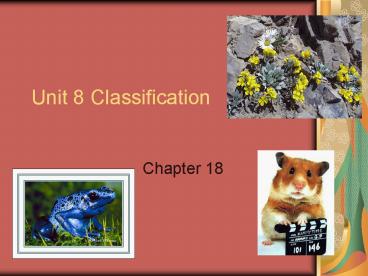Unit 8 Classification - PowerPoint PPT Presentation
1 / 10
Title:
Unit 8 Classification
Description:
To group them in a logical manner. Taxonomy process of classifying organisms ... Figure 18-5 Classification of Ursus arctos. Modern Evolutionary Classification ... – PowerPoint PPT presentation
Number of Views:50
Avg rating:3.0/5.0
Title: Unit 8 Classification
1
Unit 8 Classification
- Chapter 18
2
Why classify?
- 1.5 billion known species exist in the world
- To study the diversity of life
- To name organisms
- To group them in a logical manner
- Taxonomy process of classifying organisms
3
Assigning Scientific Names
- Binomial Nomenclature
- Created by Charles Linnaeus
- Two word naming system
- Written in italics
- First word capitalized, second lower case
- First word genus, second species
4
Classification according to Linnaeus
- System uses 7 categories (taxons)
- Largest to smallest Kingdom, phylum, class,
order, family, genus, species - Grouped according to similarities
5
Flowchart
Section 18-1
Linnaeuss System of Classification
Kingdom
Phylum
Class
Order
Family
Genus
Species
6
Figure 18-5 Classification of Ursus arctos
Section 18-1
Abert squirrel
Grizzly bear
Black bear
Giant panda
Coral snake
Red fox
Sea star
KINGDOM Animalia
PHYLUM Chordata
CLASS Mammalia
ORDER Carnivora
FAMILY Ursidae
GENUS Ursus
SPECIES Ursus arctos
7
Modern Evolutionary Classification
- Previous system was largely based on anatomy and
created some problems - Change brought by Darwins findings
- Scientist now group according to similarities and
lines of evolutionary descent
8
Evolutionary Classification
- Group organisms in categories based on lines of
descent, not just physical similarities - Cladistic analysis identifies and considers new
characteristics (derived characters) that have
arise as lineages evolve - Cladogram diagram showing evolutionary
relationships among organisms - Diagram of evolutionary tree
9
Section 18-2
Traditional Classification Versus Cladogram
Appendages
Conical Shells
Crustaceans
Gastropod
Crab
Barnacle
Limpet
Crab
Limpet
Barnacle
Molted exoskeleton
Segmentation
Tiny free-swimming larva
CLASSIFICATION BASED ON VISIBLE SIMILARITIES
CLADOGRAM
10
Classification based on DNA
- Many organisms share important similarities on
the molecular level (DNA) - Organisms grouped in categories of similar
genetic makeup - Molecular clocks DNA comparisons are used to
estimate the length of time two organisms have
been evolving independently































